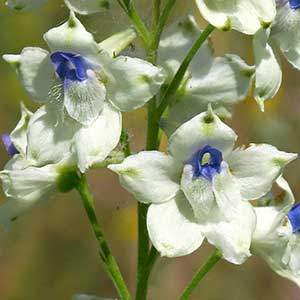Delphinium nuttallii subsp. ochroleucum
(synonym of Delphinium leucophaeum)
Delphinium inopinum
pale larkspur, white rock larkspur
unexpected larkspur
30-60 cm.
70-110(-150) cm;
base reddish or not, glabrous, often glaucous.
blade ± pentagonal, 1-5 × 1.5-7 cm, glabrous; ultimate lobes 3-9, width 5-28 mm (basal), 3-18 mm (cauline).
20-35(-51)-flowered, usually dense;
pedicel 0.3-1.5(-2.5) cm, glabrous;
bracteoles 2-4 mm from flowers, green, linear, 1-2(-4) mm, nearly glabrous.
sepals white or light yellow, spurs 9-11 mm;
lower petal blades 4-6 mm.
sepals white to light blue, glabrous, lateral sepals spreading to forward pointing, 8-12 × 3-5 mm, spurs straight to gently upcurved, ascending 30-60° above horizontal, 9-12 mm;
lower petal blades slightly elevated, ± exposing stamens, 3-5 mm, clefts 1-2 mm;
hairs centered, densest near base of cleft, white.
12-20 mm, 2.6-4 times longer than wide, glabrous.
wing-margined;
seed coat cells surfaces smooth.
= 16.
Delphinium nuttallii subsp. ochroleucum
Delphinium inopinum
Of conservation concern.
The range of morphologic features of Delphinium nuttallii subsp. ochroleucum (D. leucophaeum) is almost completely encompassed within that of D. nuttallii subsp. nuttallii. Sepal color is the only feature consistently separating the two subspecies. Were it not for the fact that any given population typically has plants of only one flower color, a rank of forma would be more appropriate.
(Discussion copyrighted by Flora of North America; reprinted with permission.)
Delphinium inopinum is apparently endemic to a white metamorphic rock substrate in the Piute Mountains and southern Sierra Nevada. It is not known to hybridize with any other species, although D. patens subsp. montanum has been collected (when both were flowering) within 1 km of D. inopinum and probably occurs much closer. Delphinium inopinum is often confused with D. parishii subsp. pallidum and superficially resembles some white-flowered individuals of D. hansenii, as well as D. gypsophilum and D. hesperium subsp. pallescens. The massive roots with prominent buds readily distinguish D. inopinum from all of these. In addition, the pubescence found on D. hansenii will separate it from the glabrous D. inopinum. Leaves are rarely seen at anthesis near the base of the stem in D. hesperium subsp. pallescens; they are present in D. inopinum.
(Discussion copyrighted by Flora of North America; reprinted with permission.)


